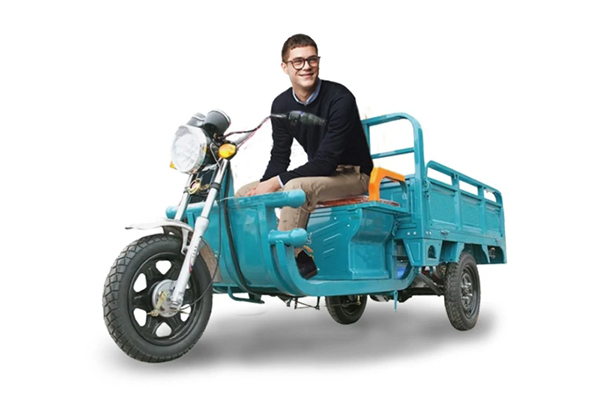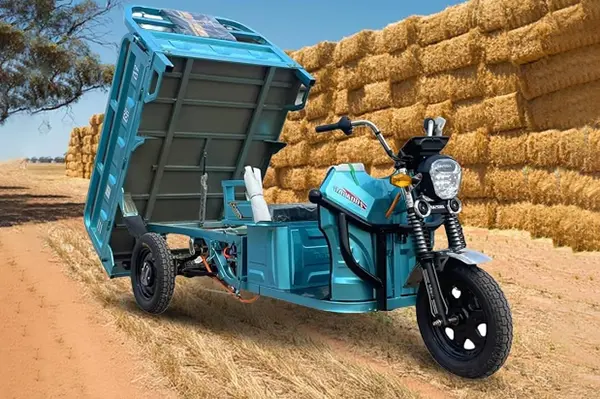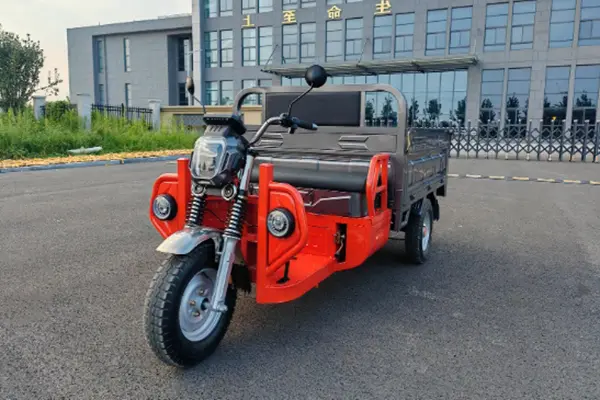Hello, my name is Allen, and for over a decade, I’ve been at the heart of the electric tricycle industry here in China. From my factory floor, I’ve watched countless three-wheeled vehicles go from raw materials to finished products, destined for businesses and communities across the globe, from the USA to Europe. I’ve spoken with hundreds of clients like Mark Thompson, a decisive business owner from the States who knows quality but demands competitive value. They’re looking for reliable fleets to power their delivery, transport, and logistics operations. This article is for them, and for you. We will explore the entire world of the 3-wheel vehicle, from the high-octane fun of a Polaris Slingshot to the workhorse efficiency of an electric cargo trike. This is your complete guide to understanding why adding a third wheel is one of the smartest moves you can make.
What Exactly Defines a Three-Wheeled Vehicle?
At its core, a three-wheeled vehicle is exactly what it sounds like: a motor vehicle with three points of contact on the ground. Simple, right? But within that simple definition lies a world of variety. The primary distinction comes down to the wheel configuration. You have two main types:
- Delta Configuration: This design features one wheel at the front and two wheels at the back. Think of a classic children’s tricycle. This setup is common in many traditional cargo and passenger tricycles, offering excellent stability for heavy loads centered over the rear axle. The single front wheel provides nimble steering, making it ideal for navigating tight urban spaces.
- Tadpole Configuration: This design is inverted, with two wheels at the front and a single rear wheel. This is the layout you’ll see on high-performance recreational three-wheelers like the Can-Am Spyder or the Campagna T-Rex. The two front wheels provide incredible cornering grip and stability at high speeds, while the rear wheel handles the power delivery. This configuration often gives a more car-like feel in handling.
Beyond the layout, these vehicles bridge the gap between cars and motorcycles. Some, like the Polaris Slingshot, have a car-like cockpit with a steering wheel and pedals, bucket seats, and a traditional dashboard. Others are clearly derived from a motorcycle, using handlebars for steering and a saddle-style seat. Understanding this basic difference is the first step in choosing the right 3-wheel machine for your needs, whether it’s for weekend thrills or weekday deliveries.

Are 3-Wheel Vehicles Safer Than a Standard Motorcycle?
This is a question I hear often, especially from clients like Mark who are building commercial fleets. The safety of their drivers is paramount. While no open-air vehicle can match the enclosure of a four-wheeled car, a three-wheeled vehicle offers significant safety advantages over a traditional two wheels motorcycle.
The most obvious benefit is stability. A three-wheeler is self-supporting. You don’t need to put your feet down at a stoplight, and the risk of a low-speed tip-over is virtually eliminated. This inherent stability is a huge confidence booster for riders who may not be comfortable on a traditional motorcycle. The wider stance, especially on tadpole designs with two front wheels, provides a much more planted feel on the road, reducing the chances of losing traction in a corner.
Furthermore, 3-wheel vehicles often come with enhanced safety features. Many models include traction control, stability control systems, and anti-lock brakes (ABS) that work on all three wheels, providing much more stopping power and control than a standard bike. They are also larger and more substantial, making them more visible to other drivers. While they retain that thrilling open-air connection to the road, the added stability and braking performance make them a compellingly safer alternative for many people. It’s a blend of motorcycle freedom and automotive peace of mind.
What Are the 10 Best and Most Famous Three-Wheelers for Recreation?
While my expertise is in commercial tricycles, I have a deep appreciation for the engineering and excitement of the recreational three-wheelers. These are the machines that turn heads and make driving an event. If you’re looking for fun, these are some of the coolest three-wheeled vehicles on the market.
- Polaris Slingshot: Perhaps the most recognizable three-wheeler in the US, the Polaris Slingshot is an open-air roadster with an aggressive, futuristic design. It features two wheels at the front, one at the back, side-by-side seating, and a steering wheel, making it feel more like a sports car than a motorcycle.
- Can-Am Spyder: The Can-Am Spyder offers a more traditional motorcycle riding position with handlebars but uses the stable tadpole design with two wheels in front. It’s known for its comfort, touring capability, and advanced electronic safety features.
- Morgan Super 3: A true classic reborn. The Morgan Super 3 from the British Morgan Motor Company is a throwback to the earliest days of motoring. It’s quirky, beautifully crafted, and provides one of the most raw and engaging driving experiences you can find.
- Campagna T-Rex RR: If you want raw performance, the Campagna T-Rex RR is a beast. Powered by a four-cylinder motorcycle engine, this 3-wheeler is essentially a street-legal race car with blistering acceleration and a high top speed.
- Can-Am Ryker: A more accessible and affordable sibling to the Spyder, the Can-Am Ryker is designed for pure fun. It’s lighter, more agile, and highly customizable, making it a popular choice for new riders.
- Vanderhall Carmel: This American-made roadster combines classic styling with modern performance. It’s a luxurious and comfortable three-wheeler that offers a refined yet exciting ride.
- Arcimoto FUV (Fun Utility Vehicle): An all-electric take on the three-wheel concept, the Arcimoto is a tandem two-seater with a full roof and a unique, narrow footprint, designed for efficient and fun urban commuting.
- Harley-Davidson Tri Glide Ultra: For the traditional touring crowd, this trike takes the classic Harley experience and adds a stable delta-style rear end with two wheels at the back, perfect for long-distance comfort.
- Ural Sidecar Motorcycle: While technically a motorcycle with a sidecar, the Ural operates as a three-wheeled machine. It’s rugged, iconic, and offers the unique ability to engage the sidecar’s wheel for two-wheel drive in tough conditions.
- Reliant Robin: A quirky icon from the UK, the Reliant Robin is famous for its single wheel at the front (delta) configuration and its tendency to be a bit… wobbly in corners. Though not a performance machine, it’s one of the most famous 3 wheelers in history.

Do You Need a Motorcycle License for a Three-Wheeled Motorcycle?
This is a critical question and the answer is… it depends. Regulations for three-wheeled vehicles vary significantly by state and country. In the past, almost any vehicle with handlebars was classified as a motorcycle, requiring a full motorcycle license or endorsement.
However, the rise of vehicles like the Polaris Slingshot has led to the creation of a new category in many places: autocycles. An autocycle is typically defined as a three-wheeled motor vehicle that has a steering wheel and non-straddle seating. In many states that recognize this class, you can legally operate an autocycle with a standard driver’s license, no motorcycle endorsement needed. This has opened up the market to a huge new audience.
For handlebar-steered models like the Can-Am Spyder, the rules are more mixed. Some states still require a full motorcycle license, while others have created a special 3-wheel-only license or endorsement that is easier to obtain. For a business owner like Mark, this is a key logistical concern. Using autocycles or vehicles that don’t require special licensing can dramatically expand the pool of potential drivers for his delivery fleet. It’s crucial to check your local DMV regulations before purchasing.
Why Are Electric Three-Wheelers Revolutionizing Urban Logistics?
This is where my passion truly lies. While recreational models are exciting, the practical application of the three-wheeled platform, especially when paired with an electric motor, is changing cities for the better. For last-mile delivery companies and logistics providers, electric three-wheelers are a game-changer.
Here’s a breakdown of the key advantages:
| Feature | Benefit for Urban Logistics |
|---|---|
| Maneuverability | A narrow frame and tight turning radius allow them to navigate congested streets and small alleys where vans can’t go. |
| Cost Efficiency | Electricity is far cheaper than gasoline, and with fewer moving parts, maintenance costs are significantly lower. MPG becomes miles per charge, and the savings are huge. |
| Eco-Friendly | Zero tailpipe emissions help companies meet green initiatives and reduce their carbon footprint in urban centers. |
| Parking | Their small size makes parking easier and faster, reducing delivery times and the risk of parking fines. |
| Payload | Modern electric logistics tricycles are designed with robust frames and can carry significant cargo, often rivaling small vans. |
From delivering groceries and packages to providing mobile food services, the electric tricycle is the perfect tool for the job. It combines the agility of a motorcycle with the utility of a small van. For business owners, this means faster deliveries, lower operational costs, and a better public image. This isn’t just a trend; it’s a fundamental shift in how we think about moving goods through our cities.
How Does a Three-Wheeled Car Handle on the Road?
Driving a three-wheeled car or trike is a unique experience that sits somewhere between a car and a motorcycle. The handling dynamics are heavily influenced by whether it’s a delta (one wheel in front) or tadpole (two wheels in front) design.
Tadpole designs, like the Slingshot, feel surprisingly stable and car-like. With two wheels at the front managing the steering and grip, you can push into corners with a lot of confidence. You’ll feel more of the road texture and lean a bit in your seat, but the vehicle itself stays remarkably flat. The single rear wheel can be prone to spinning if you apply too much power, which is why traction control is such a common feature on these high-performance machines. It’s a thrilling, connected feeling that a four-wheeled car can’t replicate.
Delta designs, like a Reliant or a cargo trike, have different dynamics. With a single wheel handling the steering, the front end can feel lighter and more nimble at low speeds. However, at high speeds, they are generally less stable in corners than a tadpole design. For their intended purpose—carrying heavy loads at moderate urban speeds—this is a perfectly effective and efficient setup. The focus isn’t on high-speed cornering but on stability under load and maneuverability in tight spaces.
What Should Fleet Managers Look for in an Electric Cargo Tricycle?
When I talk to a potential client like Mark, our conversation quickly moves past the flashy features and gets down to business. He’s not buying a toy; he’s investing in a tool for his company. Here are the key concerns we address, which any fleet manager should consider:
- Battery Range and Lifespan: This is the #1 concern. You need to know the vehicle can complete a full day’s route on a single charge. We discuss different battery options (lead-acid vs. lithium-ion) and their respective lifespans and performance in different climates. A reliable battery is the heart of a reliable electric motor vehicle.
- Motor Reliability and Power: The electric motor needs to be powerful enough to handle the maximum payload, even on steep inclines. We focus on durable, high-torque motors that are sealed against the elements to ensure long-term, maintenance-free operation. The stated horsepower should be matched to real-world performance.
- Build Quality and Durability: This is non-negotiable. The frame must be made from high-strength steel, with quality welds. The cargo box should be sturdy, and the suspension needs to be robust enough to handle rough city streets while carrying a heavy load. This is what separates a professional-grade durable electric cargo tricycle from a cheap imitation.
- Compliance and Regulations: The vehicle must meet all local safety standards. This includes things like lighting, brakes, mirrors, and horn. As a manufacturer, we ensure our products comply with international standards to make importing and registration as smooth as possible for our clients.
- Availability of Spare Parts: Even the best-built vehicle will need parts eventually. A good supplier will have a clear plan for providing spare parts and after-sales service to keep your fleet on the road, not in the garage.

Can a Three-Wheeled Vehicle Be Used for Passenger Transport?
Absolutely. The concept of the three-wheeled taxi, or "auto-rickshaw," is a staple in many parts of the world. Today, modern electric versions are providing safe, efficient, and eco-friendly transportation solutions globally. These aren’t the loud, sputtering vehicles of the past.
Modern reliable electric passenger tricycles are designed with comfort and safety in mind. They feature full-coverage roofs, comfortable bench seating for multiple passengers, and safety features like seatbelts and sturdy handholds. The quiet, smooth ride of an electric motor is a massive improvement for both the driver and the passengers.
These vehicles are perfect for a variety of applications:
- Ride-sharing services in dense urban areas or large campuses.
- Tourism operators offering city tours.
- Shuttle services for hotels, resorts, and airports.
- Community transport in developing regions or areas with limited public transit.
By offering a low-cost, low-impact way to move people, these three-wheeled passenger vehicles are empowering small business owners and improving mobility for everyone. They are a testament to the versatility of the 3-wheel platform.
What Did Historic Three-Wheelers from Mazda or Reliant Look Like?
The idea of a 3-wheeled vehicle is not new. In fact, it dates back to the very beginning of the automobile. The 1886 Benz Patent-Motorwagen, widely considered the first automobile, was a three-wheeler. Looking at some historical examples shows the creativity and diversity of the concept.
The Mazda-Go was a three-wheeled open-bed truck introduced by Mazda in 1931. It was a simple, rugged, and affordable motor vehicle that was instrumental in Japan’s post-war industrialization. It had a motorcycle-like front end with a single wheel and a large cargo bed over the two rear wheels—a classic delta design that prioritized utility above all else.
In the UK, the Reliant Robin is a cultural icon. Born from tax loopholes that favored three-wheelers, the Robin and its predecessor, the Regal, provided affordable transport for thousands of British families for decades. Its fiberglass body and one wheel at the front design made it incredibly lightweight, but also gave it a reputation for being unstable if cornered too aggressively. Despite the jokes, it was a clever piece of engineering for its time and purpose. These historic vehicles, like the strange BMW Isetta (which had two closely-spaced rear wheels), show that engineers have long been fascinated by the unique challenges and benefits of the three-wheel design.
How Do We Ensure Quality in Every Three-Wheeled Motor Vehicle We Build?
As a factory owner and a trusted Electric Cargo Tricycle, Electric Passenger Tricycle Supplier, this is the question that defines my business. My clients’ success depends on the quality of my products. It’s a responsibility I take very seriously.
Our process is built on a foundation of control and precision. It starts with sourcing high-quality raw materials. We don’t cut corners. The steel for our frames, the components for our motors, and the cells for our batteries are all sourced from reputable suppliers who meet our strict specifications. Our production lines utilize modern techniques like one-piece stamping technology for cargo beds to increase strength and durability while reducing weak points.
Every step of the way, from welding and fabrication to final assembly, is monitored by a dedicated quality control team. We conduct rigorous testing on every single vehicle that comes off the line. This includes brake tests, load capacity tests, battery-draining tests, and a thorough inspection of every nut, bolt, and electrical connection. This ensures that when a client like Mark receives a container of our tricycles in the USA, the quality is consistent from the first vehicle to the last. This commitment to quality is how we build trust and long-term partnerships.
Key Takeaways to Remember
The world of three-wheeled vehicles is diverse and full of potential. Whether for fun or for work, these machines offer a unique blend of efficiency, excitement, and utility.
- Two Main Designs: Remember the difference between Delta (1 front, 2 rear wheels) for utility and Tadpole (2 front, 1 rear wheel) for performance.
- Safety in Stability: Three-wheelers offer superior stability compared to a traditional motorcycle, making them more accessible and confidence-inspiring.
- Licensing Varies: Always check your local laws. The rise of the "autocycle" category means you might not need a motorcycle license for some models.
- The Future is Electric: For urban logistics and transport, electric three-wheelers are the clear winner, offering massive savings on fuel and maintenance while being eco-friendly.
- Quality is Key for Business: If you’re buying for a fleet, focus on build quality, battery life, motor reliability, and after-sales support. Don’t compromise on the fundamentals.
Post time: 06-17-2025




